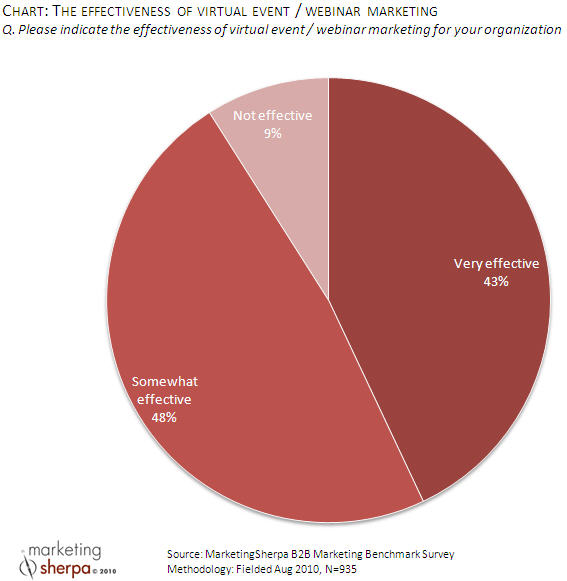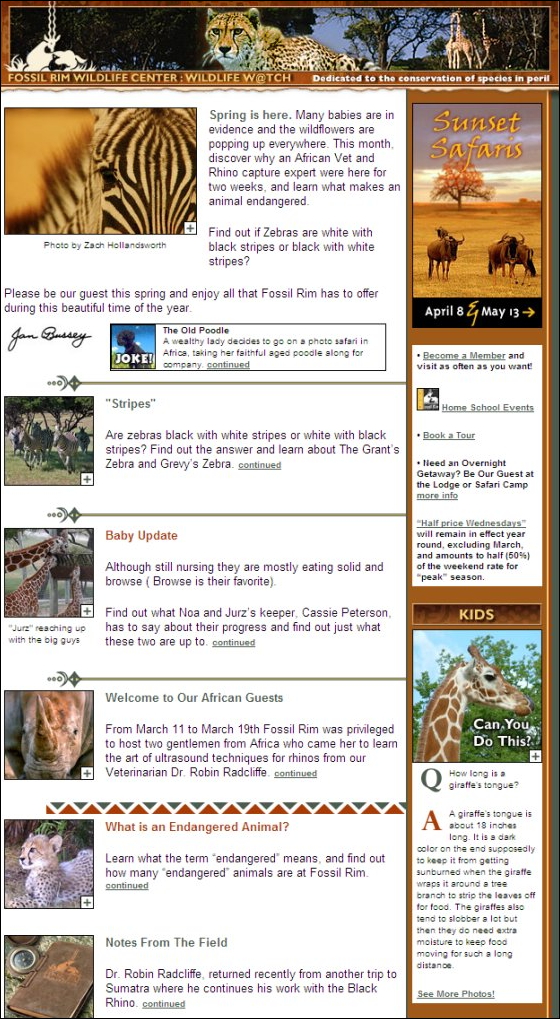Bet that title got your attention. And the answer is, “Of course not.” Tradeshows, seminars, expositions and conferences have been a key way to connect with customers and colleagues for a long time (see the recently completed MarketingSherpa B2B Summit for just one example), but these events are facing some stiff competition from cyberspace.
The MarketingSherpa 2011 B2B Marketing Benchmark Report just came out and I had the chance to review it a couple of weeks ago. The report covers B2B marketing tactics, budgeting, challenges for the coming year and more. The information was gathered through 935 marketer surveys and the report includes 167 charts and tables.
The Benchmark Report is full of great material, but one particular chart really caught my eye:

The effectiveness of webinars is significantly greater than tradeshows
Now you’re probably thinking, “What gives?” I grabbed your attention with a dramatic title and immediately calmed things down with a reassurance that tradeshows aren’t going away anytime soon. Now this bit about effectiveness? The strong numbers for the effectiveness of virtual events and webinars are very intriguing, but maybe because they are so much less expensive to execute, marketers are placing too much value in the online events.
I asked Jen Doyle, Senior Research Analyst at MarketingSherpa and Lead Author of the 2011 B2B Marketing Benchmark Report, if some of this effectiveness is related to savings over tradeshows. Here is Jen’s response, “Absolutely. In addition to the benefit of cost effectiveness, webinars also offer a balance between having one-on-one conversations with prospects as with tradeshows, and reaching a high volume of prospects which isn’t always easily accomplished at these events.
“Our 2011 B2B Marketing Benchmark Study of nearly 1,000 B2B marketers revealed that the effectiveness of webinars is significantly greater than tradeshows.”
The emphasis on her final sentence is mine. So virtual events and webinars are seen as effective, but that view comes from a lot more than simple savings over tradeshows.
What makes live events and webinars effective?
Just how effective do marketers find virtual events and webinars? Here is Jen once again, “When executed properly, virtual events or webinars can be highly effective methods in both lead generation and lead nurturing. With the execution of webinars, organizations are able to generate interest, build brand credibility and gain thought-leadership recognition – all of which will lead to results that impact a B2B organization’s bottom line.
“In this year’s B2B study, we learned that 43% of B2B organizations found virtual events or webinars to be highly effective, and another 48% to find them somewhat effective. When we compared these ratings of effectiveness to other B2B marketing tactics such as email marketing, search, telemarketing, direct mail, etc., webinars came in as the second most effective B2B marketing tactic overall, just behind website design, management and optimization.”
At MarketingSherpa, we host both live events (like the upcoming Email Summit) and webinars (like the upcoming B2B Marketing Summit Wrap-up which, ironically, is “virtual” yet based on a live event).
Webinars are a great way to maintain a regular conversation and provide consistent information to our audience throughout the year. Live events offer the opportunity to really have some deep interaction with our audience, and allows them to share knowledge peer-to-peer, marketer-to-marketer.
So both live and virtual events work for us. It’s about finding the right place and time for each, and ensuring we have a steady stream of information for our audience through the year. What about your company? What have you found works best for you?
Related resources
2011 B2B Marketing Benchmark Report
Free Executive Summary: 2011 B2B Marketing Benchmark Report
Marketing Webinar Optimization: Five questions to ask yourself about webinars
Internet Marketing Research: A behind-the scenes look at MarketingExperiments Web clinics










